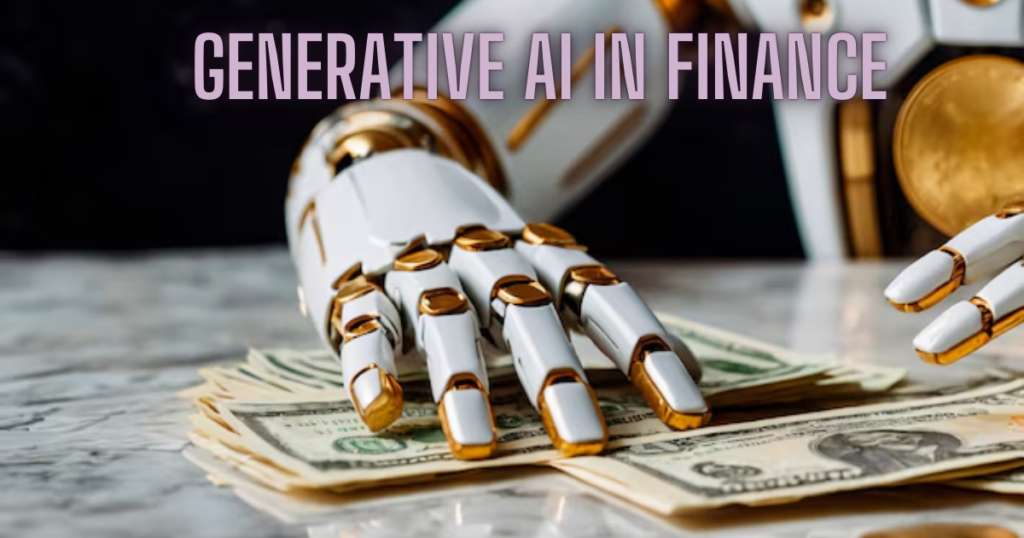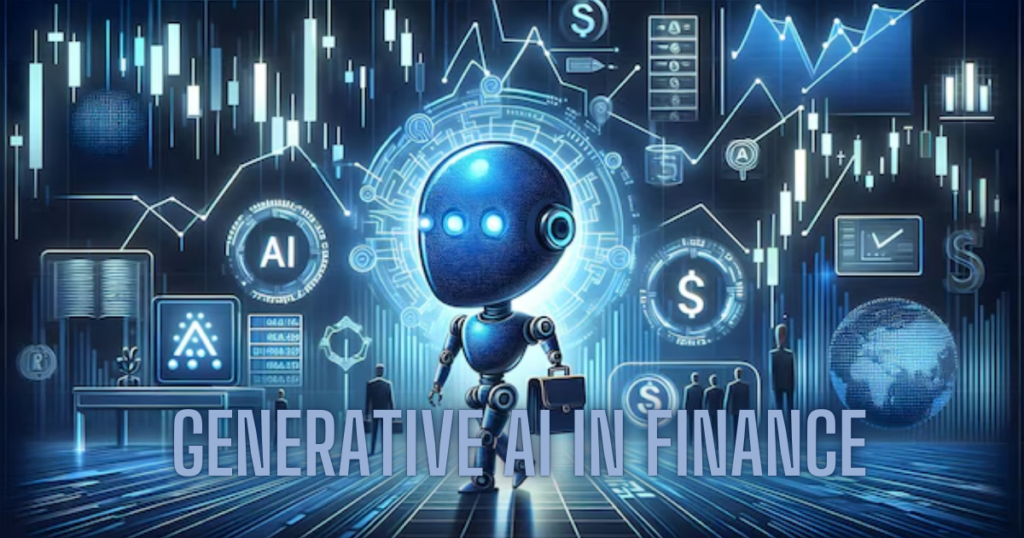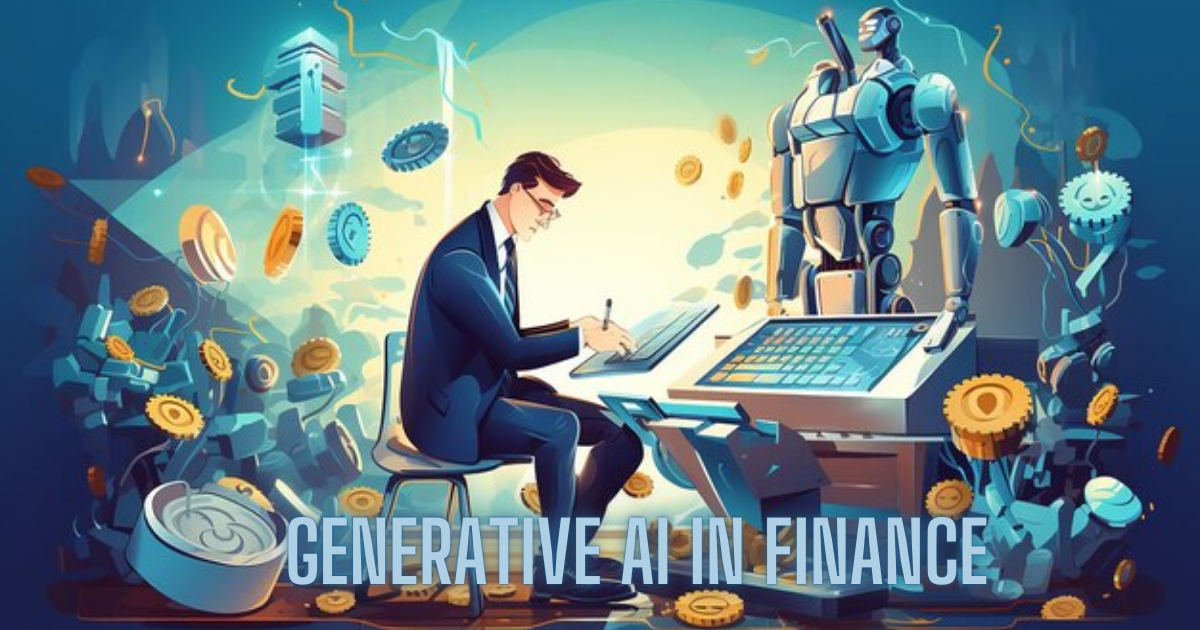Generative AI in finance is transforming the way businesses manage money. This powerful technology is opening new doors for innovation, making financial operations faster and smarter. But how does it work, and what makes it so groundbreaking? Let’s explore how generative AI is revolutionizing finance today.

- What Is Generative AI?
- Applications of Generative AI in Finance
- How Generative AI Enhances Risk Management
- Generative AI in Financial Modeling
- Fraud Detection: Generative AI as a Guardian
- The Future of Trading: AI-Driven Algorithms
- Personalized Financial Advice with AI
- Generative AI in Finance-Challenges and Limitations
- Generative AI in Finance-Real-World Impact: Case Studies
- How Generative AI Will Shape the Future of Finance
- Generative AI vs. Traditional AI: What’s the Difference?
- Conclusion-Generative AI in Finance
- Disclaimer
What Is Generative AI?
Generative AI refers to artificial intelligence that can create content, such as text, images, and even financial models. Unlike traditional AI, which is programmed to perform specific tasks, generative AI learns from data and generates new outputs. In finance, this technology is being used to create complex financial models, simulate market scenarios, and even predict stock trends.
Applications of Generative AI in Finance
Generative AI has many applications in the financial world. Some of the most common include:
| Application | Description | Benefits |
|---|---|---|
| Risk Management | Generative AI can simulate different market scenarios to assess risks. | Better risk prediction, reduced losses |
| Financial Modeling | AI generates complex models to assist in decision-making. | Faster, more accurate financial models |
| Fraud Detection | AI can find fraudulent patterns in large datasets. | Early fraud detection, improved security |
| Trading Algorithms | AI-generated algorithms make rapid trading decisions. | Increased trading efficiency |
| Personalized Advice | AI can provide customized financial advice based on user data. | Tailored investment strategies |
How Generative AI Enhances Risk Management
One of the most impressive uses of generative AI in finance is in risk management. Traditionally, banks and financial institutions rely on historical data to assess risks. But generative AI can develop new, unprojectable scenarios. It generates alternative market conditions, helping analysts foresee potential risks and minimize financial losses.
For example, a bank might use generative AI to simulate a financial crisis. By analyzing different variables, such as interest rates and stock prices, the AI can predict how the crisis could unfold and how the bank should react. This leads to more informed decision-making and better preparation for economic downturns.
Generative AI in Financial Modeling

Financial modeling is another area where generative AI is making waves. Traditionally, financial models are built manually, which can be time-consuming and prone to errors. Generative AI can quickly generate complex models based on vast amounts of data, improving both speed and accuracy.
Take the example of forecasting a company’s revenue. A financial analyst may take hours to build a model using spreadsheets and formulas. With generative AI, the same model can be generated in minutes, using real-time data and even predicting future outcomes based on current trends. This efficiency is invaluable to financial analysts who need quick and reliable models for decision-making.
Fraud Detection: Generative AI as a Guardian
Fraud detection is critical in today’s digital finance world. Financial institutions deal with millions of transactions daily, and identifying fraudulent activity in real-time is a challenge. Generative AI excels in this area by recognizing patterns in vast data sets.
Using AI, banks can generate profiles of normal transaction behaviors. When an unusual transaction occurs, the system alerts the institution to possible fraud. The AI learns and adapts over time, improving its accuracy. This helps financial institutions catch fraudulent activities early, protecting both the business and its customers.
The Future of Trading: AI-Driven Algorithms
Generative AI is also transforming trading with the rise of AI-generated algorithms. These trading algorithms analyze large datasets and generate new strategies in seconds. They can react to market trends faster than any human trader.
For instance, high-frequency trading firms are leveraging generative AI to make split-second decisions. The AI monitors market situations, predicts trends, and executes trades at lightning speed. This increases trading efficiency and allows firms to maximize their profits by capitalizing on tiny market fluctuations.
Personalized Financial Advice with AI
Generative AI has also entered the realm of personal finance. With AI, financial consultants can provide more personalized and precise recommendations. By assessing an individual’s spending habits, income, and investment history, AI can create personalized strategies to maximize returns and minimize risks.
For example, if someone wants to invest in stocks, AI can suggest the best stocks based on their personal risk tolerance and financial goals. It also updates recommendations based on changing market conditions. This level of personalization makes financial advice more accessible and tailored to individual needs.
Generative AI in Finance-Challenges and Limitations
While generative AI holds great promise, it also comes with challenges. One concern is data privacy. Financial institutions handle sensitive customer data, and the use of AI raises questions about how this data is protected. Strict regulations must be followed to ensure that data is used responsibly and securely.
Another challenge of generative AI is the risk of over-dependence on it. While AI can create valuable insights, it is important to learn that it is only as good as the data it learns from. Poor-quality data can lead to inaccurate projections and decisions. Human oversight is still needed to verify AI-generated outputs.
Generative AI in Finance-Real-World Impact: Case Studies
Several financial institutions are already seeing the benefits of generative AI. Here are two examples:
- JPMorgan Chase: The bank uses generative AI to automate parts of its risk assessment process. By simulating different market scenarios, the AI helps the bank predict potential risks and adjust its strategies accordingly.
- Mastercard: Mastercard has integrated generative AI into its fraud detection system. The AI helps the company identify fraudulent transactions by recognizing unusual patterns in real-time.
How Generative AI Will Shape the Future of Finance
Generative AI is still in its early stages, but it’s clear that it will play a significant role in the future of finance. As technology advances, we can expect even more sophisticated applications. In the future, AI could automate more complex financial tasks, such as loan approval, credit risk analysis, and portfolio management.
Quote: “Generative AI is not just a tool; it’s a revolution in how we think about finance.” – Sophia Lee, AI Researcher
Generative AI vs. Traditional AI: What’s the Difference?
| Feature | Generative AI | Traditional AI |
|---|---|---|
| Learning Capability | Can create new data and solutions | Performs pre-programmed tasks |
| Use in Finance | Predicts future market scenarios | Automates repetitive tasks |
| Decision-Making | Generates unique outcomes | Relies on historical data |
| Complexity | Handles more complex tasks | Handles simpler tasks |
Conclusion-Generative AI in Finance
Generative AI in finance is transforming the way we approach money management. From risk assessment to fraud detection, this technology is making financial processes faster, more accurate, and more personalized. While there are challenges, the potential benefits of generative AI in finance are undeniable.
Financial institutions must embrace this technology to stay competitive in the digital age. As generative AI continues to evolve, its applications in finance will only grow, shaping the future of the industry.
With the right implementation, generative AI can help financial institutions deliver better services, make smarter decisions, and provide more personalized financial solutions to clients. It’s clear that generative AI is not just a trend but a key driver of innovation in the finance sector.
Disclaimer
This article relies on internal data, publicly available information, and other reliable sources. It may also include the authors’ personal views. However, it’s essential to note that the information is for general, educational, and awareness purposes only—it doesn’t disclose every material fact. This analysis is for informational purposes only and does not constitute financial advice. Consult a professional before making investment decisions.
We publish information on World Virtual CFO in good faith, solely for general information. World Virtual CFO doesn’t guarantee the completeness, reliability, or accuracy of this information. These are our views for informational purposes. When you use our website, know that any action you take is entirely at your own risk. World Virtual CFO won’t be liable for any losses or damages connected to your use of our website. For detailed information, refer to our disclaimer page.
Dr. Dinesh Sharma is an award-winning CFO and AI strategist with over two decades of experience in financial leadership, digital transformation, and business optimization. As the founder of multiple niche platforms—including WorldVirtualCFO.com—he empowers professionals and organizations with strategic insights, system structuring, and innovative tools for sustainable growth. His blogs and e-books blend precision with vision, making complex financial and technological concepts accessible and actionable.
